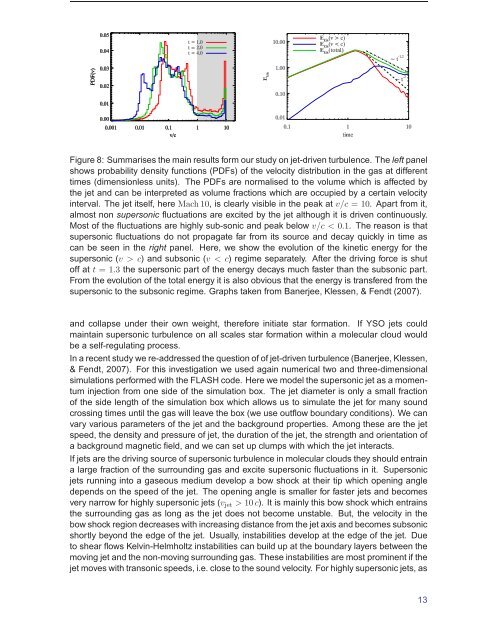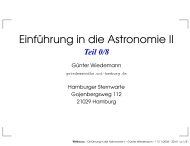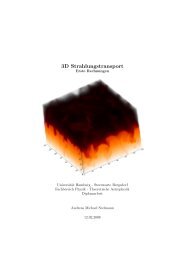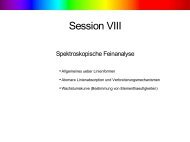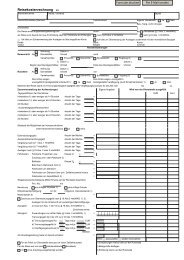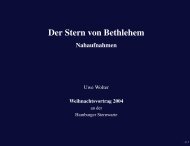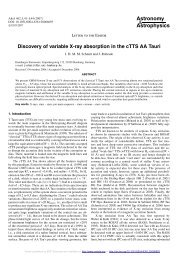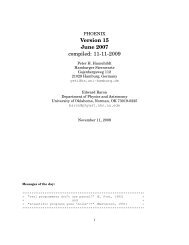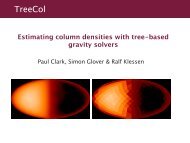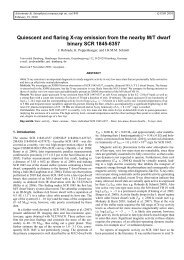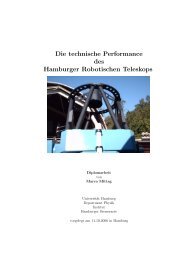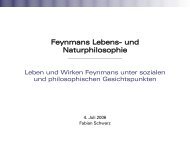Emmy Noether Application
Emmy Noether Application
Emmy Noether Application
Create successful ePaper yourself
Turn your PDF publications into a flip-book with our unique Google optimized e-Paper software.
Figure 8: Summarises the main results form our study on jet-driven turbulence. The left panel<br />
shows probability density functions (PDFs) of the velocity distribution in the gas at different<br />
times (dimensionless units). The PDFs are normalised to the volume which is affected by<br />
the jet and can be interpreted as volume fractions which are occupied by a certain velocity<br />
interval. The jet itself, here Mach 10, is clearly visible in the peak at v/c = 10. Apart from it,<br />
almost non supersonic fluctuations are excited by the jet although it is driven continuously.<br />
Most of the fluctuations are highly sub-sonic and peak below v/c < 0.1. The reason is that<br />
supersonic fluctuations do not propagate far from its source and decay quickly in time as<br />
can be seen in the right panel. Here, we show the evolution of the kinetic energy for the<br />
supersonic (v > c) and subsonic (v < c) regime separately. After the driving force is shut<br />
off at t = 1.3 the supersonic part of the energy decays much faster than the subsonic part.<br />
From the evolution of the total energy it is also obvious that the energy is transfered from the<br />
supersonic to the subsonic regime. Graphs taken from Banerjee, Klessen, & Fendt (2007).<br />
and collapse under their own weight, therefore initiate star formation. If YSO jets could<br />
maintain supersonic turbulence on all scales star formation within a molecular cloud would<br />
be a self-regulating process.<br />
In a recent study we re-addressed the question of of jet-driven turbulence (Banerjee, Klessen,<br />
& Fendt, 2007). For this investigation we used again numerical two and three-dimensional<br />
simulations performed with the FLASH code. Here we model the supersonic jet as a momentum<br />
injection from one side of the simulation box. The jet diameter is only a small fraction<br />
of the side length of the simulation box which allows us to simulate the jet for many sound<br />
crossing times until the gas will leave the box (we use outflow boundary conditions). We can<br />
vary various parameters of the jet and the background properties. Among these are the jet<br />
speed, the density and pressure of jet, the duration of the jet, the strength and orientation of<br />
a background magnetic field, and we can set up clumps with which the jet interacts.<br />
If jets are the driving source of supersonic turbulence in molecular clouds they should entrain<br />
a large fraction of the surrounding gas and excite supersonic fluctuations in it. Supersonic<br />
jets running into a gaseous medium develop a bow shock at their tip which opening angle<br />
depends on the speed of the jet. The opening angle is smaller for faster jets and becomes<br />
very narrow for highly supersonic jets (vjet > 10c). It is mainly this bow shock which entrains<br />
the surrounding gas as long as the jet does not become unstable. But, the velocity in the<br />
bow shock region decreases with increasing distance from the jet axis and becomes subsonic<br />
shortly beyond the edge of the jet. Usually, instabilities develop at the edge of the jet. Due<br />
to shear flows Kelvin-Helmholtz instabilities can build up at the boundary layers between the<br />
moving jet and the non-moving surrounding gas. These instabilities are most prominent if the<br />
jet moves with transonic speeds, i.e. close to the sound velocity. For highly supersonic jets, as<br />
13


